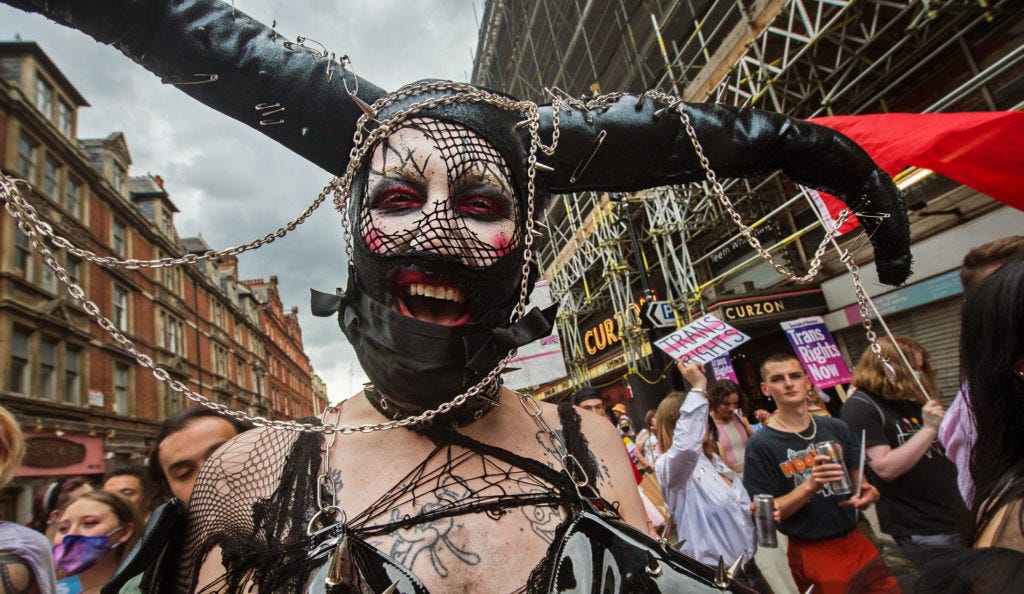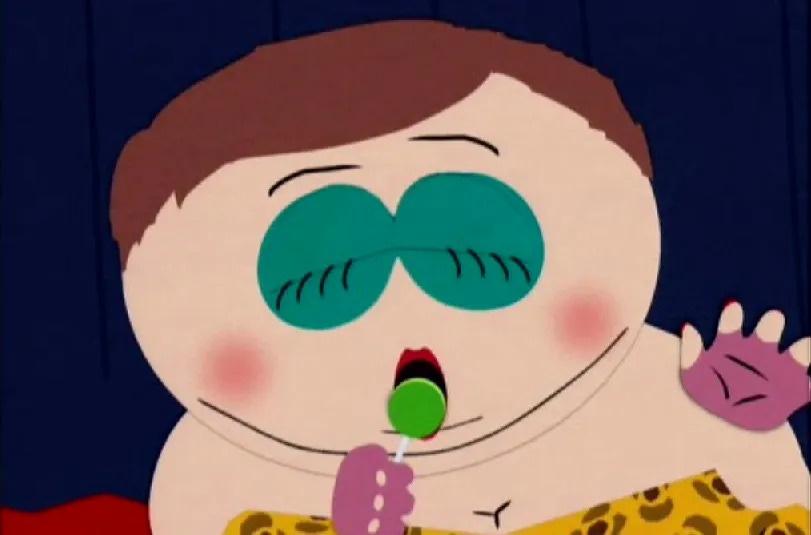Update: I saw that Dr. Blanchard has read this article.
The monstering of autogynephilia to provide the villain for the anti-“gender identity” movement has obscured Blanchard’s research on gender identity disorders so that parents, and counsellors, are now reluctant to consider whether or not autogynephilia is behind their child’s “gender identity” issues.


Stella O’Malley and Sasha Ayad are two counsellors in Ireland and the US who are sceptics of “gender identity” theory and are trying to understand the “trans” issue today from a non-ideological perspective.
In their podcast Gender Dysphoria in Boys,1 O’Malley and Ayad knew about Blanchard’s research, but felt that what they were seeing today was something different: that these boys didn’t have autogynephilia, but rather their issues regarding “gender identity” had a social cause, similar to the concept of “Rapid Onset Gender Dysphoria” (“ROGD”), a phrase that Dr. Lisa Littman coined in the research paper examining the phenomenon of rapid “trans” identification primarily amongst girls.2
O’Malley and Ayad appear to be genuinely trying to approach the “trans” issue from a non-ideological perspective, however it was evident how much their view of autogynephilia had already been coloured by the anti-“gender identity” movement: their theory of “Rapid Onset Gender Dysphoria” in boys arguably shows more insight into the views of parents and counsellors regarding autogynephilia, rather than insight into the psychology of boys with issues around “gender identity”.
“Ruminative” and “sensitive” character traits and autogynephilia not mutually exclusive
I think the episode would have been a lot different had it been framed instead by the “coming out” of Abigail Thorn earlier that month, the philosophy YouTuber who had also been interviewed by the BBC,3 or even referenced “Contrapoints”, also a philosophy graduate.4
With this alternative framing, it would have made their theory that boys who were “ruminative” and “sensitive” were disqualified from having autogynephilia, harder to justify as not just being prejudice against autogynephilia, picked up from the anti-“gender identity” movement.
Apparent delayed sexuality is a feature of autogynephilia
There were many such instances in the podcast where what was seen as a disqualification from autogynephilia, could be instead seen as a “for this reason”, such as the presumption that autogynephilia meant an excess of sexuality, or sexual maturity.
A delayed or lack of sexual maturity is a feature of autogynephilia, as autogynephilia is an inwardly-directed sexuality (analloerotic), it can nullify outwards (alloerotic) gynephilic (attraction towards women) interest, or mean that such interest is delayed.5
Autogynephilia vs autogynephilic disorder
O’Malley and Ayad talked about the subject of pornography in the podcast, especially the increasing amount of pornography that exists entirely in fantasy, revolving around images or scenarios that cannot even exist in real life, drawing boys further and further away from reality.
The DSM6 makes the distinction between experiencing the phenomenon, which might not be distressing, and its capability of turning into a disorder, where for some, it can impair everyday life, and/or cause an identity disorder.
While pornography does not cause autogynephilia —discussion of the autogynephilia under labels such as “Eonism” was happening far prior to the advent of streaming pornography7 — it is arguable that the increase of pornography for niche fantasies can be responsible for turning what in the past what would have gone unobserved, into an autogynephilic disorder, where autogynephilia fantasy negatively affects everyday life.
Stigma that now surrounds autogynephilia
Although arguably the theory of “ROGD boys” shows more insight into the psychology of parents and counsellors and their discomfort about the myths that have been created around autogynephilia, the label “ROGD boy” could at least be an alternative from a female “gender identity” that might protect them from “gender identity” ideology. Given that there exists today such a stigma around autogynephilia, that did not exist a decade ago, labelling boys with “autogynephilia” could in itself be harmful.
However it remains that “autogynephilia” is a word that is used to describe a real, and confusing, phenomenon, for the male who has it. The phenomenon doesn’t go away, if the word “autogynephilia” stops being used: boys with autogynephilia will likely continue to search for something that explains what they are feeling and hopefully they will find and base their decisions around Blanchard’s research on autogynephilia, rather than “gender identity”.
Autogynephilia understood as caricature
The podcast referred to someone under the pseudonym of Angus Fox who is described as an academic, before changing roles into a journalist, interviewing the parents of boys who identify as “trans”. It is unclear what qualifications he has regarding gender identity disorders or working with children.


It is understandable why Fox would be popular with parents, as he offers them an alternative explanation to the extreme stigma around autogynephilia. It is imaginable that every parent would feel anxiety presented with the idea that their boy has autogynephilia, if they feel about it in the same way as Fox does: that it is a “highway to Yaniv-ery, with no exit ramps”, referring to Jessica Yaniv, a male who became notorious for suing a salon when they refused to wax his male genitalia.8
It is perhaps unsurprising that Fox feels extreme reluctance to consider boys have autogynephilia, as Fox seemingly views autogynephilia entirely through the lens of feminists in the anti-“gender identity” movement, whose political goal is to monster autogynephilia.
Fox’s caricature of autogynephilia shows a lack of responsibility for someone who presents themselves as helping adolescent boys who are distressed regarding their sex. Fox knows that some adolescent boys will be autogynepihlic, “isn’t all” means some, and he holds them up to ridicule.
Describing autogynephilia
Ayad and O’Malley also interview Fox in their podcast series.9 It seemed that the cover of “ROGD boys” could at least allow them to talk about autogynephilia in boys in a way that would avoid the controversy if they had done so explicitly:
I found it interesting about the avatars, because that’s usually the first experimentation, just picking an avatar for a game that is a girl, or a girly screen-name, and starting to posture in these online forums like Reddit. I get curious about, is there a way then teenage boys’ sexuality is overlapping with these sexy gaming characters…
Fox ends the podcast, again, with a statement that rather reveals the theory of “ROGD boys” has more to do with the anxiety of parents, rather than the psychology of boys, presenting the false dichotomy of “perverts” versus “brilliant people… intelligence… off the charts”:
I just want to get it out there that there maybe some people who perhaps in the past have been a wee bit dismissive of the boys, a little bit too ready to say “It’s autogynephilia, they’re perverts” and I would say to those people, you know what, we’re all on a learning curve with this… these parents have been vilified, and it’s without reason, and these young men have so much to offer the world; they are such brilliant people, and their parents are pretty brilliant as well, and so it’s just that’s why I’m ultimately optimistic, as I think the level of intelligence in these groups, are off the charts, so one way or another, we’re going to get the right outcome.
Fox seems to think that being gifted in some way, and having autogynephilia is mutually exclusive. But again, when one is familiar with this topic, profoundly gifted autogynephilic males are not difficult to find.
One example would be Lynn Conway, who was instrumental in the development of the microprocessor, and was “shy” and had gender dysphoria as a child.10
Attacked from both sides
While the theory of “ROGD boys” can be disputed, it does however seem the case that O’Malley and Ayad are genuinely trying to approach the issue of “trans” with an open mind, guided by studies and evidence.
Unfortunately, in doing so, they have also been attacked by ideologues on both the “gender identity” and anti-“gender identity” sides. As is usual amongst primarily online social justice movements, the form of aggression was attempted reputation destruction.
O’Malley has been accused of not caring about the people who come to see her by “gender identity” activists. Likewise, feminists on the anti-“gender identity” side have deliberately misconstrued jokes on O’Malley and Ayad’s podcast as safeguarding incidents, showing a lack of awareness that by falsely raising safeguarding concerns for political reasons, they themselves are undermining the concept of safeguarding.
Both the “gender identity” and feminist social justice movements have their own reason to attempt to shut down the conversation about boys and autogynephilia.
The “gender identity” ideologues don’t want autogynephilia being talked about full-stop, as it undermines their idea of the male or female “gender identity”.
Feminists who want to caricature those with autogynephilia as the oppressor cannot permit talking about boys with autogynephilia, as this is to undermine their oppressor vs. oppressed narrative. Many of this group have come to deny that autogynephilia exists at all in boys, contrary to all research, and sometimes even despite adolescent boys talking directly with them about their experience of autogynephilia on social media platforms.
To those members of the anti-“gender identity” movement who funnel vitriol indiscriminately towards autogynephilia, it will also be an unpleasant fact that this vitriol will inevitably spill over onto boys who are struggling with their identity, therefore it is easier to hold the belief that boys with autogynephilia do not exist.
It is unfortunate that “ROGD boys” is presented with such as prejudiced misconception of autogynephilia, as there might be also something new happening with boys to explain why they are pushed away from wanting to be male, which is part 8 in this series.
Update 2: I summarised all my thoughts on the “trans” issue in a standalone memo on a separate Substack.
“Gender dysphoria in boys episode 20 part 1” O’Malley, S., Ayad, S. Gender: a wider lens podcast 23 April 2021.
“Rapid-onset gender dysphoria in adolescents and young adults: A study of parental reports.” Littman L (2018) PLoS ONE 13(8): e0202330.
“Abigail Thorn: “I came out as trans and made headlines’” BBC 3 April 2021.
Autogynephilia can vary in degree, from coexisting with outward heterosexuality, to nullifying it. “The Classification and labelling of nonhomosexual gender dysphorias”. Blanchard, R., Ph. D. Archives of Sexual Behavior 18(4) 315-334 p. 324.
Diagnostic and Statistical Manual of Mental Disorders
“Havelock Ellis (1859–1939), another of the great, classic sexologists, had perceptions similar to Hirschfeld’s, although he couched them in somewhat different language. Ellis used the term Eonism, usually in regard to nonhomosexual males, to designate overt cross-gender behavior as well as subjective feelings; he sometimes used an alternative term, sexo-aesthetic inversion, for the same thing. In his view: “The Eonist is embodying, in an extreme degree, the aesthetic attribute of imitation of, and identification with, the admired object. It is normal for a man to identify himself with the woman he loves. The Eonist carries that identification too far. (1935, p. 244)” “Early history of the concept of autogynephilia”, Blanchard, R. PhD. Archives of Sexual Behavior. 2005 Aug;34(4):439-46.
“Gender dysphoria in boys episode 21 part 2” O’Malley, S., Ayad, S. Gender: a wider lens podcast 30th Apr 2021.




